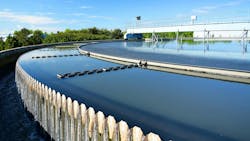For biosolids management professionals, all the news around regulations is enough to make one’s head spin. What follows are some key points that can help wastewater professionals put it all into context and guide the way they approach per- and polyfluoroalkyl substances (PFAS) in biosolids — even as things keep changing.
PFAS in biosolids and on ski slopes
Earlier this week my wife’s uncle sent me and my brother-in-law, who works for the Utah Division of Water Quality, a news article recently published in the Salt Lake Tribune citing a study in Park City that linked PFAS to ski wax. Alas, as a competitive cross-country ski racer, I have been one of the contributors to the PFAS contamination in Park City. Mea culpa. I still have fluorinated ski wax in my garage next to my ski waxing station, but do not worry, I am no longer using it. I will dutifully turn in the wax to a local ski outfit that will dispose of it. On second thought, maybe I will leave that wax retired in my garage until I have confidence that it can be safely disposed of (more on that later).
Turns out, these carbon-fluorine bonds have become especially useful for firefighting foam suppressants (not a subject to trivialize), nonstick cookware, stain-resistant products, fast food packaging, personal care products, and, well, ski wax. Humans have come to rely on hard, slick substances in their lives, the likes of which will last “forever.” PFAS seems to be literally and figuratively everywhere. It will not go away. In addition to my now-retired fluorinated ski wax, my tooth floss, and the packaging for take-out food (which I will continue to use because I really need an occasional pizza and Vietnamese food), PFAS is influencing just about every project I work on now. These projects all include biosolids management, biosolids planning studies, or process engineering in the early stages of design.
We are facing a challenging time in biosolids management. As regulatory agencies react to ongoing changes and guidance around PFAS, biosolids treatment facilities and those who operate and manage them are, in some cases, flummoxed. Regulatory uncertainty is presenting some limits in how we manage biosolids, especially when it comes to treating biosolids to remove PFAS.
In my days as a graduate student at the University of Utah School of Business, one of the most useful classes I attended was one on organizational management where we focused quite a bit on problem solving. My professor wanted us to understand how to define problems as either convergent or divergent, for example, or how problems affect us. Some of the most vexing problems are ones that affect us on a personal, organizational and societal level. And when problems diverge, or become more complex as we discover more variables, they are more difficult.
Indeed, PFAS is affecting humans at the personal and societal level (whether they know it or not). For those of us grappling with it at work, we can see this problem at an organizational level, too. And again, to compound the PFAS problem, it seems to be diverging.
Engineers love convergent problems; ones that have one clear answer with the ultimate satisfaction of the exclamatory, “Yes!” But, no, PFAS will not provide that satisfaction, and issues with biosolids management seem to be in the category of minimizing risks and dealing with degrees of probability. In most cases, there will not be a final, obvious, convergent solution that is undeniably true.
Where does this leave us in biosolids management?
Recently, the U.S. Environmental Protection Agency (EPA) has announced definitive rulemaking and guidance.
On April 19, the EPA Biosolids Program in the Health and Ecological Criteria Division designated perfluorooctanoic acid (PFOA) and perfluorooctanesulfonic acid (PFOS) as hazardous substances. This is a final rule under the Comprehensive Environmental Response, Compensation, and Liability Act (CERCLA).
A week before that, the EPA provided much-needed guidance on technologies that destroy PFAS. Destruction of PFAS is a term that is often used by folks in our business when they should probably be using terms like PFAS removal or transformation. Those words would better indicate that the PFAS might be removed from the residuals, or it might have been transformed into another compound. But destroying PFAS is a tough thing to do.
Most experts agree that it takes a process 1,000 °C to mineralize PFAS or separate the carbon-fluorine bond. However, 1,000 °C is more theoretical than empirical. Indeed, we do not have much real data. The EPA has recently finalized some of the testing methodologies that should help us figure out how to measure it.
In addition to temperature, the amount of residence time and turbulence in the process are important variables to achieve destruction. This notion of temperature dosing is akin to pathogen destruction for Class A biosolids, so these variables are relatable. So, will putting wastewater residuals (or my ski wax) into a thermal process destroy PFAS, or will it result in releasing it into the atmosphere from incomplete destruction? Will it not negatively affect the environment, or will it at least result in a net positive impact?
The short answer is, we do not know. That is why the EPA is partnering with agencies to better understand the mass balance and the fate of PFAS.
7 steps to plan for PFAS removal
With all this information and (hopefully) interesting, relatable anecdotes, what is my guidance to the biosolids management community?
1. Take a deep breath.
Our industry is no stranger to contaminants: dioxins, radionuclides, phthalates, pharmaceuticals, heavy metals and endocrine disruptors, generally. The list goes on. That said, PFAS is different from any other contaminant, and we could see additional regulations around PFAS that could impact biosolids and wastewater. Luckily these compounds are evident in low concentrations. But without context and understanding it is, well, scary. Remember to take a deep breath, follow the science and the process, stay informed, and continue to make progress.
2. Source control is the first logical step
Yes, first let’s turn off the PFAS faucet. Several states are enacting PFAS bans to aggressively stop PFAS at the source. Historically, these types of contaminants have been effectively managed at the source. While there has been some hyperbole in recent years from the professional community, there is consensus around source control as a first logical step.
3. Do not lose sight of the big picture
If we are going to transform our systems into a circular economy and stop extracting, using, and wasting, then we must deal with these inconvenient truths and educate ourselves and the public about the actual risks. We must close the loop on resources that can be recovered efficiently: nutrients, energy, and water. This is true for conventional wastewater treatment, and it is also true for municipal solid waste, agricultural waste, and food and beverage waste.
4. Make investments with stranded asset mitigation
We can continue to extract energy and nutrients from wastewater residuals (and other waste streams). Good, old-fashioned anaerobic digestion, in all its forms, continues to be a solid investment and can complement thermal processes, if needed in the future. Anaerobic digestion extracts energy from readily biodegradable material and conserves nutrients that can be returned to soils. Anaerobic digestion can be a solution for wastewater residuals and a solution for other organic waste streams. Anaerobic digestion is quite compatible with downstream processes that further enhance the biosolids or thermally treat it. In short, go forth and digest.
5. Make investments in research
While you are happily anaerobically digesting, invest in research that aims to manage or destroy PFAS. This does not have to happen at every facility. Let’s use our institutions to help lead this process. Contribute to research foundations, influence the process, and support our regulatory framework. Partner with leading agencies who are at the forefront of the research. Create efficiencies through collaboration!
6. Purge the biases
Leave the “magical thinking”— it is not serving you well. This work is not easy and must be dealt with objectively. I see too many people in our industry making rash decisions (or recommendations) with incomplete information. I know it is uncomfortable not to solve a problem in front of you, but PFAS is complex. Trust the science, our processes, and institutions — and contribute collaboratively.
7. These issues will persist
Let’s take a moment to realize that PFAS in biosolids is an acute issue. But frankly, there will be more emerging contaminants going forward. This is the nature of the beast. We must deal with PFAS in addition to other contaminants, we must continue to educate, and we must transform our systems to be sustainable and circular.
Stay flexible and accept this mission
Residuals and biosolids management are facing a critical time as we learn more about PFAS and receive new guidance. While we do not have all the answers now, we can still think strategically and plan for PFAS removal.
Stay flexible and remember that change will be ongoing. This is our mission as biosolids management experts. Let’s embrace it.
About the Author

Dru Whitlock
Dru Whitlock is vice president and global practice leader for biosolids and energy recovery at Stantec.


